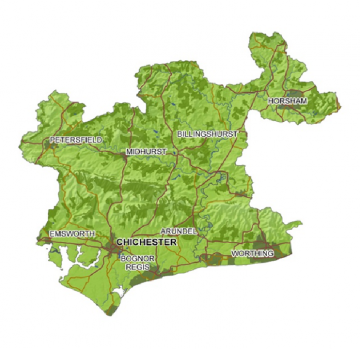
The Arun and Western Streams catchment covers 1,490 square kilometres (575 square miles, 149,000 hectares or over 368,000 acres). It is dominated by the chalk ridge of the South Downs and the sand and clay of the Weald, and lies predominantly within the new South Downs National Park.
The two main rivers, the Arun and the Western Rother, flow through some of the most picturesque countryside in the South of England. The Arun from its source near Horsham runs south to Pulborough (Stopham Bridge) where it is joined by the Rother which has its origins in Hampshire. These two rivers now become one, the tidal Arun, and continue flowing south, cutting through the chalk above Arundel, until they enter the sea at Littlehampton. The catchment also includes the rivers flowing south from the Downs towards Chichester and the coast.
Anglers are probably the largest group who use the river for recreation. There are numerous angling clubs and associations whose members are often to be seen on the banks. Any pollution, or obstructions that affect the welfare of the numerous varieties of fish that inhabit the rivers, is of major importance. Likewise bird lovers are attracted to the ever-changing comings and goings that take place throughout the year so access is important to this increasing group of enthusiasts. Small boats and canoes, better suited to the tidal Arun, need safe and agreed launching places. There are also those who just like to walk along the riverbanks and enjoy all they have to offer. All are part of a community that enjoys and benefits from having these wonderful rivers close by.
The catchment is also vital for business, particularly for farmers. Dairy cows, beef animals and sheep all need the lush summer grazing and winter silage and hay from the river valleys, whilst the Rother valley and the Chichester Plain are important for salad crops, potatoes, glasshouse production and horticulture.
In addition, more than 400,000 people, over half the population of West Sussex, live in the catchment, and they all need clean water supplied to their houses and sewage taken away, so the water companies are very important to the health of our rivers and their environment.